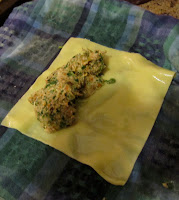 |
| Homemade pasta with Brussels sprouts and toasted pecans. |
I’ve always wanted to be a vegetarian, but I just can’t
picture myself having my last cheeseburger ever. A few weeks ago, Trevor shared
the concept of a TED talk he’d heard. Basically, you become a weekday
vegetarian, but still eat meat on the weekends. He said he wanted to try it.
And it was something I could get behind, too. We’d be eating more healthfully, saving
money, reducing our environmental impact and giving way less money to companies
that treat animals inhumanely. And I’d never have to completely give up
cheeseburgers.
 |
| Spicy cauliflower pasta |
We had already incorporated many vegetarian dinners into our
repertoire, but it’s been a challenge to find more tasty meatless meals. The
Moosewood New Classics cookbook has been our go-to book. But I was getting a
little tired of it, so I started looking through my other cookbooks that
weren’t necessarily vegetarian. In our giant Pasta cookbook, I found a spicy
cauliflower pasta. With homemade noodles and Persephone golden cauliflower, it
was a keeper.
My Martha Stewart New Classics cookbook had a section on
meatless main dishes and number of tasty soups and pastas that fit into our
weekday needs. Trevor filled in at Hollywood Farmers’ Market on Saturday, so
we’re stocked with lovely fall produce from Persephone, including my favorite,
Brussels sprouts. Martha had a wonderful recipe for Brussels sprouts with
walnuts and pasta. Since Trevor can’t eat walnuts we used toasted pecans
instead. And I out Martha-ed Martha by using homemade fettuccine instead of
store-bought, dried pasta.
For the pasta, the Brussels sprouts are cored and then the
leaves are pulled off. They are sautéed in butter with red onion and garlic.
Fresh sage and thyme added even more fall flavors to the mix. Then the pasta is
added to the Brussels sprouts and it’s topped with browned butter, pecans and
grated cheese. (I used less butter than called for – ½ cup plus 3 tablespoons.)
We used Parrano cheese instead of Parm. I served it slices of wheat baguette,
roasted Persephone delicata squash, and Trevor’s Persephone mixed greens. It
was unbelievably good. Probably one of the best meals we’ve had lately —
vegetarian or not.
Link:














































